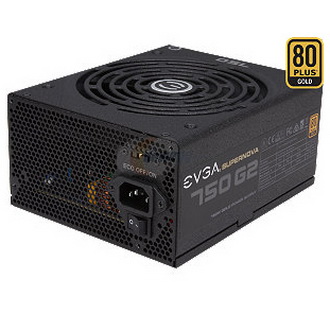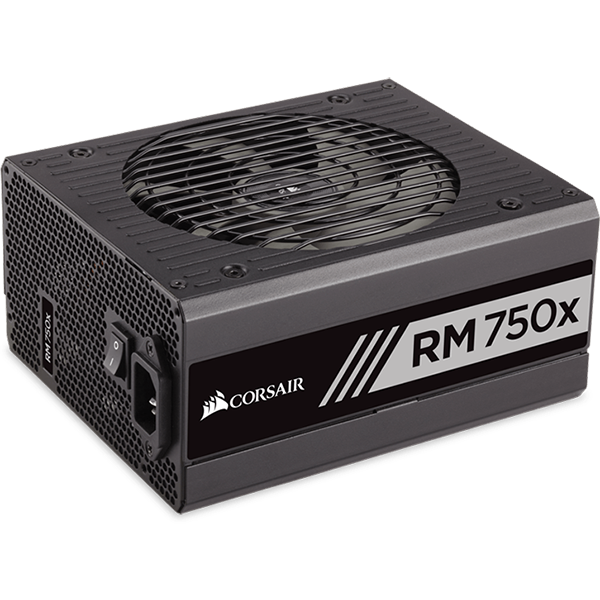Enermax Revolution X’t II 750W Power Supply Review
Enermax recently released a successor to the Revolution X't line and the new models are made by CWT, featuring 80 PLUS Gold efficiency, Japanese caps and a quality fan. Today, we're testing the ERX750AWT model.
Why you can trust Tom's Hardware
Load Regulation, Hold-Up Time And Inrush Current
To learn more about our PSU tests and methodology, please check out How We Test Power Supply Units.
Primary Rails And 5VSB Load Regulation
Load Regulation testing is detailed here.


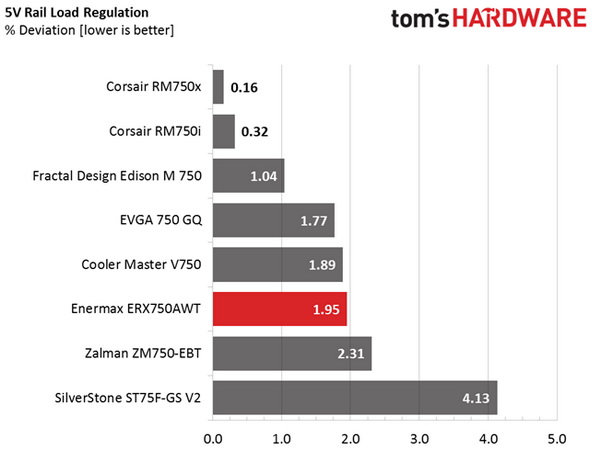
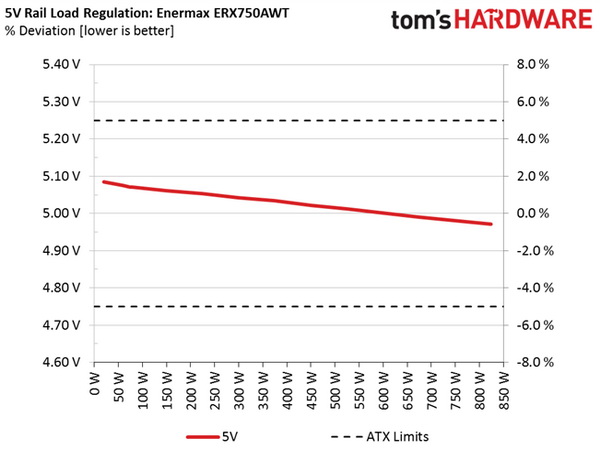
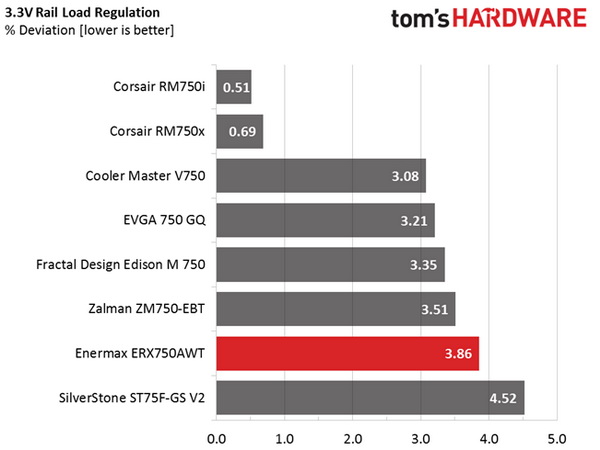



Hold-Up Time
Our hold-up time tests are described in detail here.
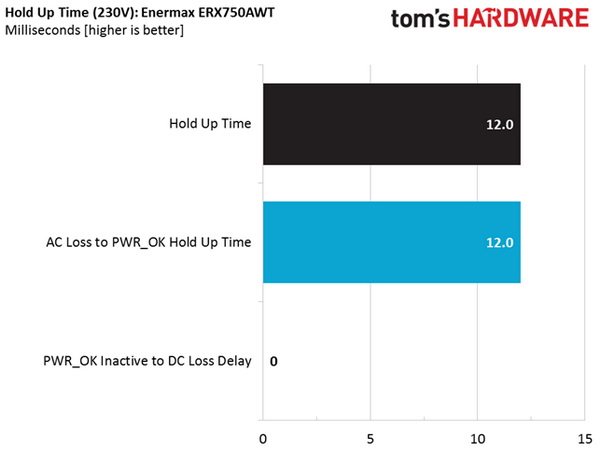
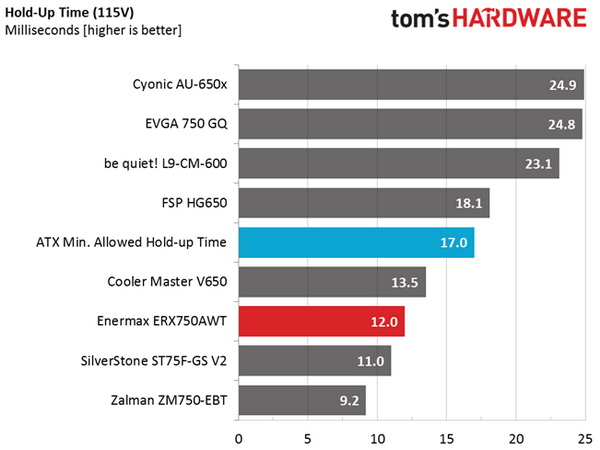
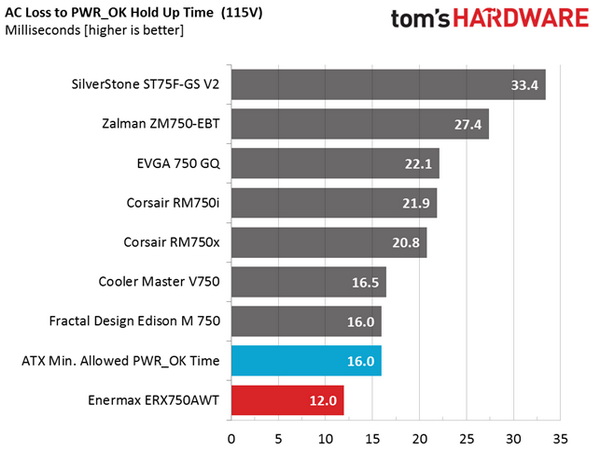
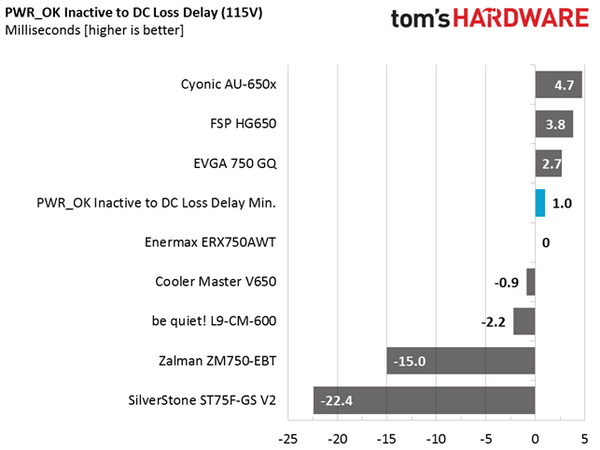
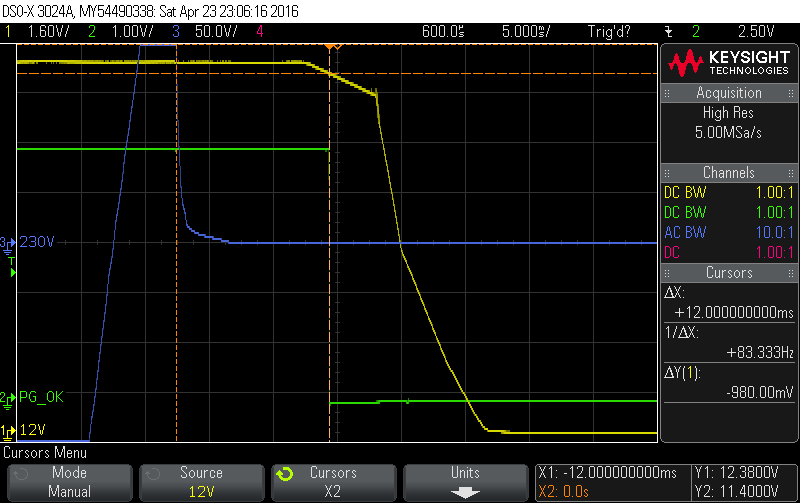
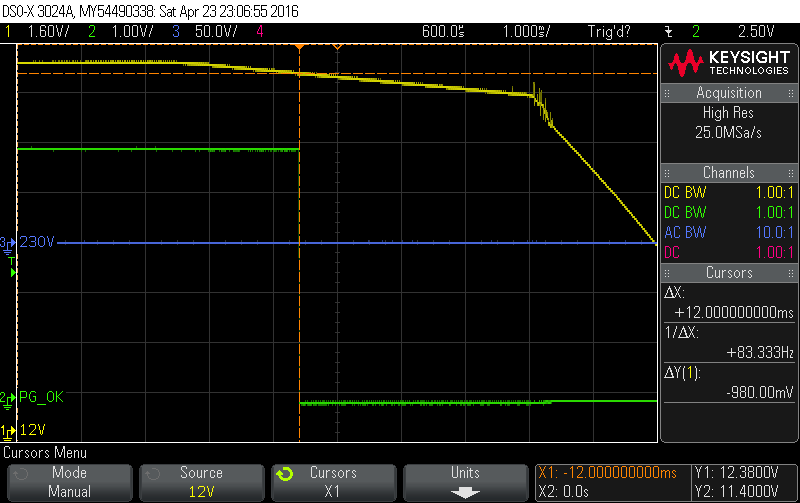
Not only is the hold-up time lower than 17ms, but it matches the power-good hold-up time. Normally, that latter measurement should be at least 1ms lower to let the system shut down before the rails go out of spec. We've seen much worse cases though, where the power-good signal drops when the rails are already out of spec.
The worst part is that, after a couple of test cycles, the PSU stopped working following the explosion mentioned on the previous page. Again, we don't think this is a fundamental issue with the design since the main FETs are strong enough to handle our abuse.
5/1/2016 Update: The second sample finally arrived and this time we didn't encounter any problem switching on and off the PSU during full power delivery. We conducted multiple test cycles and all rolled fine, so apparently the issue that we faced with our first sample was just an isolated incident.
Inrush Current
For details on our inrush current testing, please click here.
Get Tom's Hardware's best news and in-depth reviews, straight to your inbox.

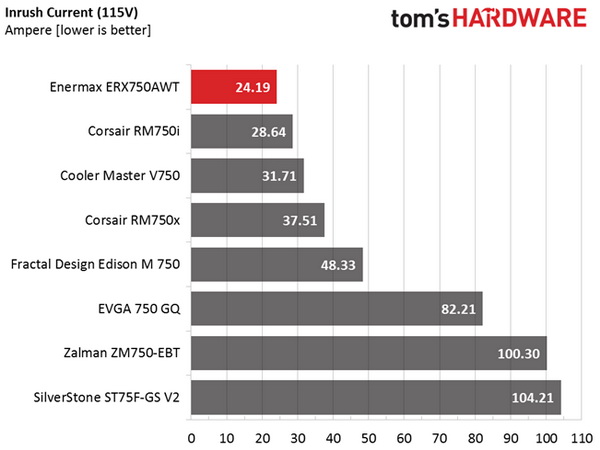
The inrush current is low with both voltage inputs.
Load Regulation And Efficiency Measurements
The first set of tests reveals the stability of the voltage rails and the PSU's efficiency. The applied load equals (approximately) 10 to 110 percent of the maximum load the supply can handle, in increments of 10 percentage points.
We conducted two additional tests. During the first, we stressed the two minor rails (5V and 3.3V) with a high load, while the load at +12V was only 0.10A. This test reveals whether a PSU is Haswell-ready or not. In the second test, we determined the maximum load the +12V rail could handle with minimal load on the minor rails.
| Test # | 12V | 5V | 3.3V | 5VSB | DC/AC (Watts) | Efficiency | Fan Speed (RPM) | Noise (dB[A]) | Temps (In/Out) | PF/AC Volts |
|---|---|---|---|---|---|---|---|---|---|---|
| 1 | 4.405A | 1.974A | 1.950A | 0.984A | 74.77 | 85.23% | 805 | 30.1 | 37.62 °C | 0.967 |
| 12.073V | 5.071V | 3.383V | 5.062V | 87.73 | 42.32 °C | 115.1V | ||||
| 2 | 9.856A | 2.958A | 2.937A | 1.185A | 149.70 | 89.68% | 805 | 30.1 | 38.27 °C | 0.980 |
| 12.059V | 5.061V | 3.368V | 5.049V | 166.93 | 43.27 °C | 115.1V | ||||
| 3 | 15.669A | 3.465A | 3.451A | 1.386A | 224.84 | 90.98% | 805 | 30.1 | 39.21 °C | 0.984 |
| 12.047V | 5.053V | 3.358V | 5.036V | 247.12 | 44.77 °C | 115.1V | ||||
| 4 | 21.480A | 3.963A | 3.942A | 1.591A | 299.66 | 91.09% | 805 | 30.1 | 39.89 °C | 0.986 |
| 12.034V | 5.043V | 3.347V | 5.025V | 328.98 | 46.99 °C | 115.1V | ||||
| 5 | 26.969A | 4.968A | 4.948A | 1.795A | 374.69 | 90.92% | 805 | 30.1 | 40.88 °C | 0.988 |
| 12.021V | 5.034V | 3.333V | 5.010V | 412.10 | 48.64 °C | 115.1V | ||||
| 6 | 32.464A | 5.973A | 5.967A | 1.998A | 449.56 | 90.41% | 805 | 30.1 | 42.09 °C | 0.988 |
| 12.007V | 5.022V | 3.316V | 4.997V | 497.25 | 52.06 °C | 115.1V | ||||
| 7 | 37.968A | 6.988A | 6.996A | 2.205A | 524.53 | 89.03% | 1000 | 36.2 | 43.35 °C | 0.987 |
| 11.995V | 5.012V | 3.301V | 4.984V | 589.15 | 53.96 °C | 115.1V | ||||
| 8 | 43.502A | 7.999A | 8.032A | 2.411A | 599.46 | 88.21% | 1240 | 43.6 | 43.97 °C | 0.988 |
| 11.978V | 5.001V | 3.287V | 4.971V | 679.59 | 55.44 °C | 115.1V | ||||
| 9 | 49.481A | 8.514A | 8.579A | 2.415A | 674.50 | 87.37% | 1600 | 47.4 | 45.49 °C | 0.989 |
| 11.963V | 4.990V | 3.274V | 4.965V | 771.99 | 57.65 °C | 115.0V | ||||
| 10 | 55.435A | 9.041A | 9.101A | 2.520A | 749.38 | 86.54% | 1600 | 47.4 | 45.80 °C | 0.990 |
| 11.945V | 4.981V | 3.263V | 4.953V | 865.93 | 58.82 °C | 115.1V | ||||
| 11 | 61.784A | 9.056A | 9.124A | 2.525A | 824.23 | 85.61% | 1600 | 47.4 | 47.10 °C | 0.991 |
| 11.929V | 4.972V | 3.254V | 4.946V | 962.73 | 61.10 °C | 115.1V | ||||
| CL1 | 0.099A | 14.022A | 14.005A | 0.004A | 117.70 | 83.16% | 805 | 30.1 | 43.61 °C | 0.980 |
| 12.069V | 5.027V | 3.284V | 5.057V | 141.54 | 54.36 °C | 115.1V | ||||
| CL2 | 61.945A | 1.002A | 1.003A | 1.002A | 753.50 | 87.34% | 1600 | 47.4 | 45.63 °C | 0.990 |
| 11.948V | 5.018V | 3.334V | 5.003V | 862.72 | 58.17 °C | 115.0V |
Efficiency definitely satisfies the 80 PLUS Gold standard, since even at high ambient temperatures we see numbers that meet the corresponding requirements at 20 and 50 percent load. Moreover, they're only 0.5 percent away from the desired 87 percent mark under full load. The PSU's fan rotates slowly at up to 60 percent load and only hits full speed with 90 to 110 percent of the PSU's max-rated capacity applied. Under normal conditions, we expect this PSU to be very quiet.
Load regulation at +12V is pretty tight. At 5V and 5VSB it's satisfactory, while at 3.3V it's loose. Fortunately for Enermax, this rail is of secondary importance.
Current page: Load Regulation, Hold-Up Time And Inrush Current
Prev Page A Look Inside And Component Analysis Next Page Efficiency, Temperature And Noise
Aris Mpitziopoulos is a contributing editor at Tom's Hardware, covering PSUs.
-
powernod The fact that the PSU collapsed during the "Hold-UP time / Power_OK" tests, clearly proves -in my opinion-, how important these tests are, since they are an indication of how properly a PSU can react during stressful situations. ;)Reply -
turkey3_scratch Good unit. Has some things that could be improved, but good. Wish there was much more to say.Reply -
Aris_Mp actually I rarely see a PSU going boom in these tests. Will wait for the second sample to arrive and see how it goes under the same scenario.Reply -
turkey3_scratch Reply17939497 said:actually I rarely see a PSU going boom in these tests. Will wait for the second sample to arrive and see how it goes under the same scenario.
Oh I thought you already got the second sample and it tested fine, guess I misread that. -
GearUp The older line X't have been selling for around $82 so I would have hoped for a lower price as well. Personal experience still favors Enermax since 0/6 of my units failed within 3 months while it was 1/3 for each of 2 different competitors. I still factor in return costs at this point.Reply -
Aris_Mp Just finished testing the second sample and no fireworks this time, so apparently the incident with the first sample (during the hold-up time tests) was just an isolated one.Reply
In addition I confirmed that there is no OCP on the minor rails either, as I suspected. -
android_dev The older Enermax Revolution 87+ series have better build quality ,features and performance than their X't counterparts. Then again it was a more expensive platform to begin with.Reply -
GearUp Correction on returns: Only one supply was returned within 3 months which is good for returns. The other failed due to the motherboard or graphics card after 16 months. Some supplies have return rates well over 20 percent.Reply

